If you’ve ever walked through dry farmlands or thorny scrublands of India at dawn, you may have heard a loud, cackling call that sounds like “kik-ki-kik-ki-ki”. This is the unmistakable voice of the Grey Francolin, also known as the Teetar in many Indian languages. Small, sandy-brown, and swift on its feet, this bird blends into the arid landscapes it calls home, yet its presence has been deeply woven into India’s culture, agriculture, and folklore for centuries.
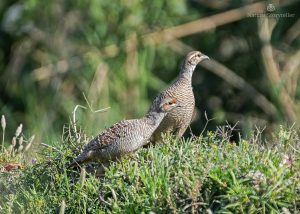
The Grey Francolin is not just a bird, it is a symbol of resilience in harsh climates, a farmer’s companion in the fields, and a familiar character in stories passed down through generations.
Whenever we Nature Storytellers go for birdwatching, sighting the Grey Francolins always excites us a lot.
How to Identify a Grey Francolin
Grey Francolins are plump, ground-dwelling birds that resemble partridges or quails. They are often seen running across open fields in pairs or small groups.
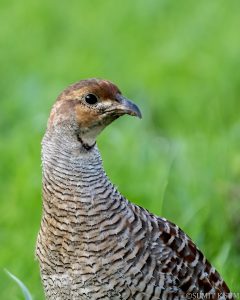
Key Features of Grey Francolin
| Size | About 30–34 cm long; larger than a quail, smaller than a junglefowl. |
| Plumage | Sandy brown body with fine black-and-white barring; provides excellent camouflage in dry grass and scrub. |
| Head & Throat | Greyish face with a pale throat patch. |
| Wings & Tail | Rounded wings and short tail, built for quick bursts of flight. |
| Sexes | Males and females look alike, though males may have spurs on their legs. |
| Call | A loud, harsh, repetitive “kik-ki-kik-ki-ki”, often heard at dawn and dusk. |
Children often recognize the Grey Francolin more by its noisy call than by its appearance!
Habitat and Distribution of Grey Francolin
Grey Francolins are adaptable birds found in a variety of open and semi-arid landscapes.
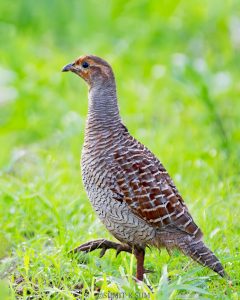
Grey Francolin Habitat
- Dry scrublands and thorn forests
- Farmlands and village outskirts
- Grasslands and open countryside
- Roadside thickets and orchards
Range:
- India: Widespread across most of the country, especially in northwestern, central, and peninsular India.
- Also found in Pakistan, Nepal, Bangladesh, and Iran, and introduced in places like the Middle East.
They avoid dense forests and wetlands, preferring open country where they can run and feed easily.
For a splash of forest colour, explore the hidden beauty of the Indian Pitta.
Behaviour and Social Life of Grey Francolin
Grey Francolins are shy but sociable birds.
- Usually seen in pairs or small coveys of 5–10 birds.
- Prefer running swiftly through grass rather than flying; if startled, they take off with noisy wingbeats and loud calls.
- Known for their dust-bathing behaviour in dry soil.
- Roost in low shrubs or trees at night to avoid predators.
They are alert sentinels of the countryside, their loud alarm calls often warn other animals (and even farmers) of approaching danger.
Also Read: India’s Biggest Land Bird, the Sarus Crane
Diet: What Do Grey Francolins Eat?
Grey Francolins are omnivores with a varied diet:
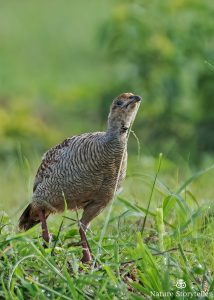
- Seeds and grains (millet, wheat, sorghum, rice)
- Green shoots and buds
- Insects and small invertebrates (termites, beetles, grasshoppers)
- Occasional small reptiles or fallen fruits
This diet makes them both beneficial for pest control and occasionally a competitor for crops.
Breeding and Nesting of Grey Francolins
The breeding season is usually from March to September, often peaking just before the monsoon.
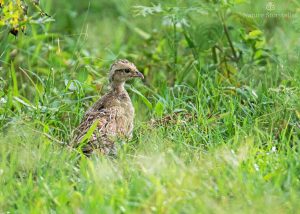
- Nesting: A shallow scrape on the ground lined with grass.
- Eggs: Typically 5–8 pale, buff-colored eggs.
- Chicks: Precocial—hatch fully covered with down and can walk soon after.
Both parents are protective, and coveys often include juveniles from the same brood.
Migration in Grey Francolins
Unlike migratory quails, Grey Francolins are resident birds. They do not migrate long distances but may move locally in search of food and water, especially during droughts.
Their adaptability helps them survive in dry regions where few other birds thrive.
See how migration and nesting compare in the elegant Indian Paradise Flycatcher.
Similarities and Differences with Other Partridges and Quails
| Feature | Grey Francolin | Jungle Bush Quail |
Black Francolin |
| Size | Larger (30–34 cm) | Smaller (17–19 cm) | Similar size but darker |
| Plumage | Sandy brown with barring | Darker, spotted | Bold black-and-chestnut with white patches |
| Call | Loud “kik-ki-kik” | Rolling “prr-prr-prr” | Shrill “klik-click-click” |
| Habitat | Open fields, scrublands | Scrub and forest edge | Wetlands, agricultural fields |
This comparison helps birders avoid confusion in the field.
Also Read: Rain Quail
Conservation Status of Grey Francolin
- IUCN Red List: Least Concern
- Population: Stable across most of its range
Threats:
- Habitat loss due to intensive farming and urban expansion
- Over-hunting in some regions (for meat and sport)
- Pesticides reducing insect prey
Despite these threats, their adaptability and wide distribution ensure they remain common in much of South Asia.
Grey Francolin in Culture and Literature
Like the majestic Indian Peafowl, the Grey Francolin is woven into tales and traditions of Indian fields.
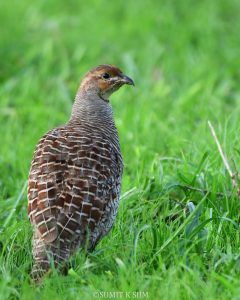
In Folklore:
- Known as “Teetar”, it features in rural songs, riddles, and proverbs.
- Its duet-like calls are often compared to friendly conversations between neighbors.
- Farmers regard it as a bird of the fields, closely tied to the agricultural cycle.
In Literature:
- In Hindi and Urdu poetry, the Teetar’s calls are metaphors for restlessness and longing.
- In folktales, it is often portrayed as a clever yet cautious bird.
- Its pairing habits have made it a symbol of companionship and loyalty.
Children in rural areas often learn to mimic its loud call, making it a playful part of village life.
Suggested Read: Papiha or Common-Hawk Cuckoo
Why the Grey Francolin Matters?
Beyond its cultural importance, the Grey Francolin is a vital indicator of healthy farmlands and scrublands.
Protecting its habitat means protecting India’s grassland ecosystems, which support countless other species.
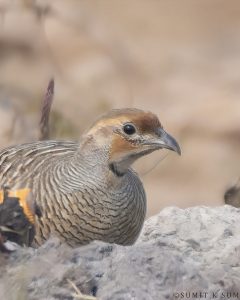
The Grey Francolin is more than just a bird of the dry fields—it is a guardian of farmlands, a symbol of companionship in folklore, and an essential part of India’s natural heritage. Whether you’re a child enchanted by its loud call or a birder searching for it in the scrub, this little partridge continues to connect people to the rhythms of the land.
Written and Image Courtesy: Nature Storyteller Sumit K Sum
